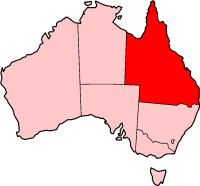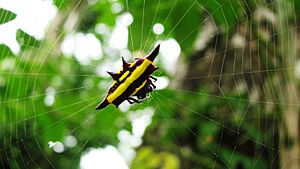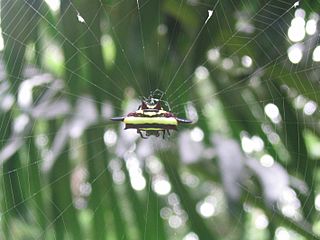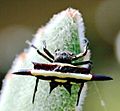Gasteracantha fornicata facts for kids
{{Speciesbox |taxon = Gasteracantha fornicata |image = Gasteracantha_fornicata_2.jpg |image_caption = In Northern Queensland, Australia |authority = Fabricius, 1775 |synonyms_ref = |synonyms =
- Aranea fornicata Fabricius, 1775
- Gasteracantha vittata L. Koch, 1871
- Gasteracantha bradleyi Thorell, 1881

The Gasteracantha fornicata is also known as the northern jewelled spider. It is a type of spiny orb-weaver spider. You can find it in Queensland, Australia. This spider looks a bit like another spider called Austracantha minax.
A scientist named Johan Christian Fabricius first described this spider in 1775. It was the very first Australian spider to be officially named and classified. Sometimes, spiders get different names over time. This spider was once called Gasteracantha vittata. But scientists found its first name, given in 1775, was the correct one.
Female G. fornicata spiders have cool patterns. They have bright yellow or white stripes on their dark bodies. They also have small yellow or white spots underneath. These spiders are "sit-and-wait" hunters. They wait for small insects to come close to their webs. Gasteracantha fornicata spiders build round, "orb-shaped" webs. They often decorate their webs with silk tufts.
Contents
About the Northern Jewelled Spider
Gasteracantha fornicata is a small spider. It can look different in size and color. It has hard spines on its back. These spines are part of its outer skeleton. The spider's wide body might make it less quick than other spiders.
Male spiders are usually about two millimeters long. Females can grow up to twelve millimeters. Female spiders have clear stripes on their backs. These yellow or white bands stand out against their dark bodies. These bright colors help them attract prey. The underside of their body is darker with small yellow spots.
Like other spiny spiders, Gasteracantha fornicata has a tough outer shell. The spines on its back help protect it from predators. The spider's bright colors might also warn predators to stay away.
Spider Color Variations
Female Gasteracantha fornicata spiders have two main color types. Some have bright yellow stripes, and others have white stripes. The white-striped spiders do not have the same special UV light properties as a related spider, Gasteracanthra cancriformis.
These different colored spiders live in different parts of the rainforest. For example, white-striped spiders are more common in darker areas. This is because their white stripes show up better against cloudy skies.
Spider Family and Relatives
Gasteracantha fornicata belongs to the Araneidae family. These are also known as orb-weaver spiders. All spiders in this group build round, "orb" shaped webs. Many spiders in this family, like Gasteracantha fornicata, decorate their webs.
The name Gasteracantha means "spiny abdomen." These spiders are known for their spiny parts and bright patterns. This spider is thought to be closely related to Gasteracantha minax.
Where They Live
Gasteracantha fornicata spiders come from the rainforests of Northeast Australia. You can find them mainly at the edge of the tree line. The amount of cloud cover and sunny spots in their home affects the color of female spiders. Also, long periods of rain can make their webs not work well.
What They Eat
How They Hunt
Gasteracantha fornicata eats small insects, just like other spiders in its group. Their diet includes small flies, small hymenopterans (like bees), Orthoptera (like grasshoppers), Odonata (like dragonflies), and Lepidoptera (like butterflies). The spider's color does not change what it eats. Building its web is the main effort for this spider to find food.
Gasteracantha fornicata positions itself and its web to use light and dark areas. The spider's stripes look like the environment. This helps them attract prey. Prey often mistake the light patches for places to find food or mates. This is a clever trick for Gasteracantha fornicata.
Yellow-striped spiders catch the most prey when their stripes stand out the most. White-striped spiders catch the most prey when their brightness stands out. Both types of spiders catch and eat prey at similar rates.
The spider's colors also trick the eyes of flies and bees. White-striped spiders look like flowers to these insects. Yellow-striped spiders also look like yellow flowers. If the spider's stripes are covered, it catches fewer prey.
Spider Webs
Web Design
Gasteracantha fornicata builds a circular, "orb" shaped web. This is typical for spiders in the Araneidae family. Gasteracantha spiders are known for having very strong webs.
Like other spiders in its family, Gasteracantha fornicata uses a "sit-and-wait" hunting method. But unlike some "sit-and-wait" hunters that hide, Gasteracantha fornicata is brightly colored. This bright color helps the spider attract prey to its web. Spiders with their clear stripes attract more prey than spiders whose stripes were hidden.
Catching Prey
Spiny orb-weavers often add silk tufts to their webs. These decorations are placed along the web's frame. Scientists think these tufts might attract prey, like a "sensory trap." However, these decorations do not seem to help the spider catch more food.
These decorations might also scare away birds or other predators. Webs without decorations are more likely to be destroyed by larger animals. But Gasteracantha spiders build their webs in sheltered spots, like shrubs. These areas are less likely to be disturbed by big predators. Even with decorations, webs can become useless during long rainstorms.
Reproduction and Life Cycle
Spider Life-span
The life of a Gasteracantha fornicata spider begins as an egg. The egg sac of Gasteracantha fornicata is made of bright green silk. It is shaped like an oval and is about twelve to fifteen millimeters wide.
The spider grows through several stages called instars. After these changes, its final adult form has a hard outer shell and its famous spines. The spider's size and look can change during its life. If there is not enough food or if it does not rain much, the spider can lose weight and its colors may become less bright.
Mating Behavior
Male and Female Spiders
Male and female Gasteracantha fornicata spiders look very different. This is called sexual dimorphism. Males are much smaller (2mm) than females (12mm). Males also have a different shape.
Male spiders live on the edges of the female's web. To mate, the small male must quietly travel to the female in the center of the web. He must do this without freezing or being shaken off by the female. Then, he climbs onto the female and mates. This mating behavior is special to the Gasteracantha group of spiders. Other spiders in the Araneidae family might make a special mating thread for the female to follow.
Spider Enemies
Who Hunts Them
Birds and humans are possible predators of this spider. The webs of Gasteracantha fornicata and other decorated web spiders may help protect them from predators. The bright decorations on the webs draw the attention of larger creatures. This can stop them from destroying the web.
The spider's hard head and body spikes also help protect it. For example, the mud dauber wasp Sceliphron laetum feeds its young with orb-weaving spiders. But it does not use Gasteracantha spiders because their outer shell is too hard. The spider's bright colors might also be a warning sign to larger predators not to hunt it.
Spider Colors and Behavior
The yellow stripes on female Gasteracantha fornicata spiders come from special pigments. These pigments help the spider absorb different kinds of light. Gasteracantha fornicata spiders can copy the patterns and colors of local flowers. This helps them trick insects looking for nectar and pollen.
The spider's striped pattern of yellow or white and black looks like the attractive patterns of flowers. While color alone helps attract prey, the pattern itself did not always affect how many prey were caught. However, other studies show that the direction of the stripes is important.
Spider Body Features
How They Stay Warm
Gasteracantha fornicata spiders control their body temperature by how much sun they get. This depends on their position in the web. They can position themselves parallel to the sun's direction. This helps them get the most sun exposure. Some spiders build web structures to create shade. But Gasteracantha webs do not seem to help them cool down.
Spiders and People
Gasteracantha fornicata was the first spider from Australia to be classified by European scientists. It was likely collected by J. Banks or C. Solander during James Cook's first voyage in 1770. This spider was probably found near the Endeavour River, close to what is now Cooktown.
Images for kids
-
In Cooktown





